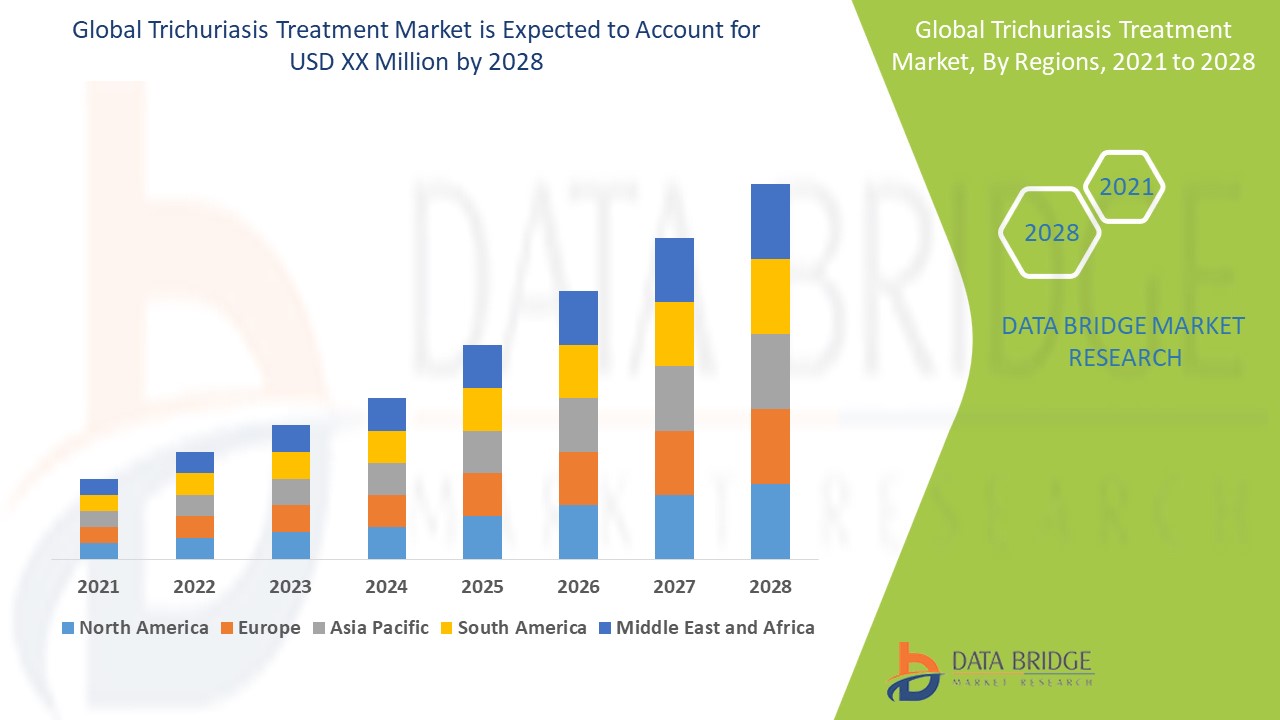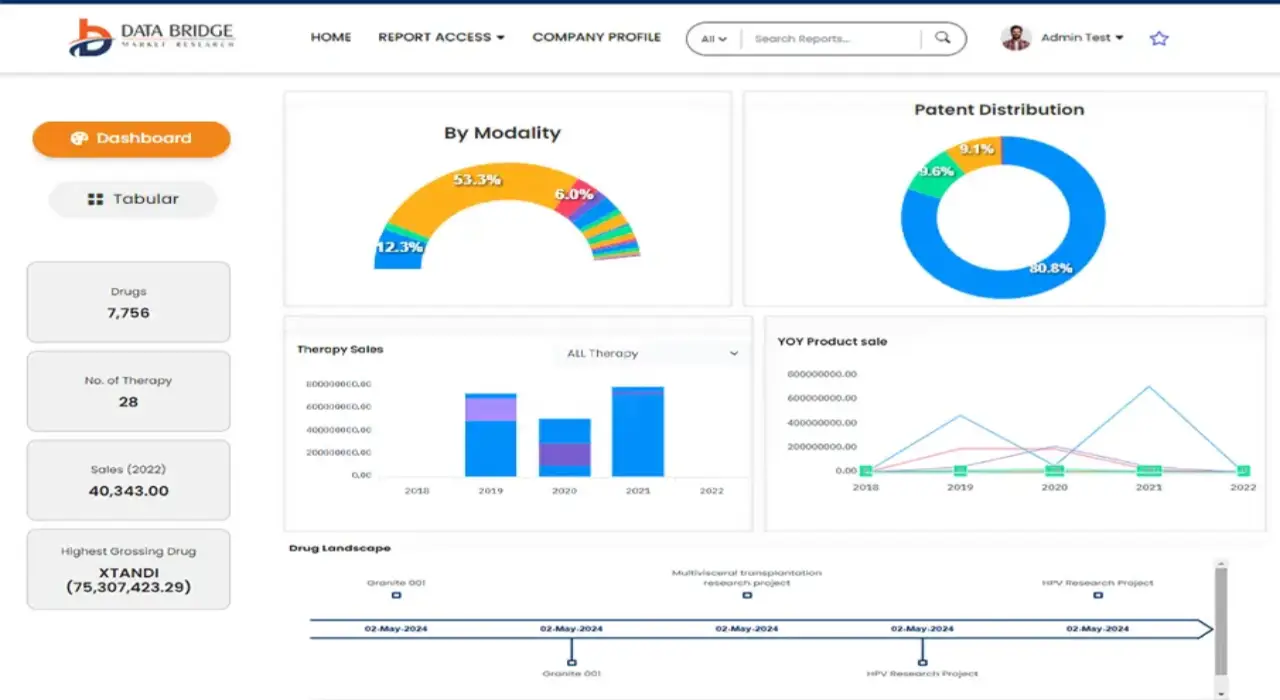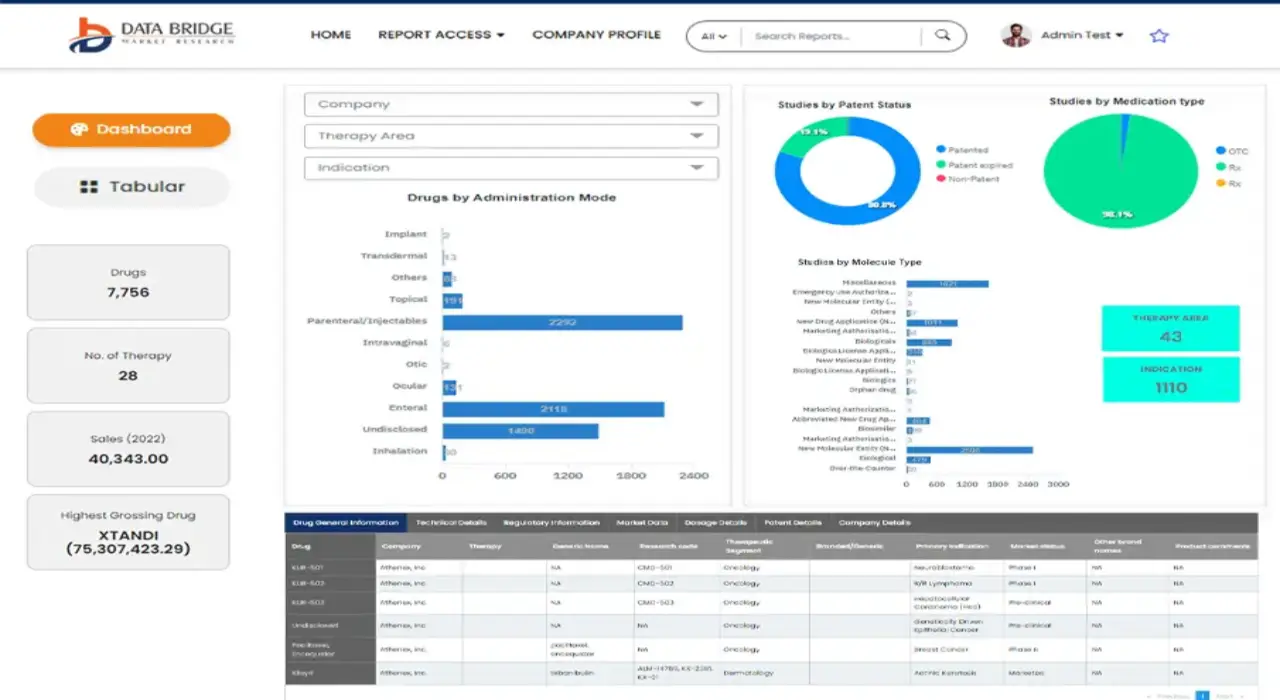Global Trichuriasis Treatment Market
Market Size in USD Billion
CAGR :
% 
 USD
1.78 Billion
USD
2.76 Billion
2024
2032
USD
1.78 Billion
USD
2.76 Billion
2024
2032
| 2025 –2032 | |
| USD 1.78 Billion | |
| USD 2.76 Billion | |
|
|
|
|
Global Trichuriasis Treatment Market Segmentation, By Route of Administration (Oral, Injectable, and Topical), Age Group (Children, Adults, and Elderly), Treatment (Albendazole, Mebendazole, and Others), End User (Hospital, Specialty Clinics, Ambulatory Surgical Centers, and Others), Distribution Channel (Hospital Pharmacy, Retail Pharmacy, and Online Pharmacy) – Industry Trends and Forecast to 2032
Trichuriasis Treatment Market Analysis
The trichuriasis treatment market has seen advancements with the development of more effective and targeted therapies. One of the latest methods is the use of combination therapies, where drugs such as mebendazole and albendazole are paired with newer agents for enhanced efficacy. These treatments are increasingly used in areas with high incidence rates, especially in developing countries.
In terms of technology, diagnostic tools such as PCR-based testing and serological assays have become essential for early detection and precise diagnosis of trichuriasis, contributing to better patient outcomes. The integration of AI and machine learning in analyzing patient data is also aiding in identifying the best treatment regimens, improving cure rates and reducing reinfection.
The market is growing due to increasing awareness, government initiatives, and the rising burden of soil-transmitted helminths, particularly in tropical and subtropical regions. Improved access to healthcare and innovations in drug delivery systems, such as sustained-release formulations, are boosting market expansion. Moreover, global collaborations are accelerating the development of new treatments and improving their accessibility in endemic areas.
Trichuriasis Treatment Market Size
The global trichuriasis treatment market size was valued at USD 1.78 billion in 2024 and is projected to reach USD 2.76 billion by 2032, with a CAGR of 5.60% during the forecast period of 2025 to 2032. In addition to the insights on market scenarios such as market value, growth rate, segmentation, geographical coverage, and major players, the market reports curated by the Data Bridge Market Research also include depth expert analysis, patient epidemiology, pipeline analysis, pricing analysis, and regulatory framework.
Trichuriasis Treatment Market Trends
“Increased Adoption of Novel Anthelmintic Drugs in Trichuriasis Treatment”
A significant trend driving the growth of the trichuriasis treatment market is the increased adoption of novel anthelmintic drugs. Traditional treatments have been facing challenges due to drug resistance, which has prompted a shift towards newer, more effective therapies. Drugs such as Mebendazole and Albendazole are being supplemented by emerging treatments, such as Nitazoxanide and Nitromidazoles, which offer higher efficacy in treating Trichuris trichiura infections. For instance, the World Health Organization (WHO) has endorsed the use of combination therapies to combat resistant strains, helping improve treatment outcomes. This innovation in drug therapies is boosting the market, providing more effective solutions for managing and eradicating trichuriasis.
Report Scope and Trichuriasis Treatment Market Segmentation
|
Attributes |
Trichuriasis Treatment Key Market Insights |
|
Segments Covered |
|
|
Countries Covered |
U.S., Canada and Mexico in North America, Germany, France, U.K., Netherlands, Switzerland, Belgium, Russia, Italy, Spain, Turkey, Rest of Europe in Europe, China, Japan, India, South Korea, Singapore, Malaysia, Australia, Thailand, Indonesia, Philippines, Rest of Asia-Pacific (APAC) in the Asia-Pacific (APAC), Saudi Arabia, U.A.E, South Africa, Egypt, Israel, Rest of Middle East and Africa (MEA) as a part of Middle East and Africa (MEA), Brazil, Argentina and Rest of South America as part of South America |
|
Key Market Players |
Novartis AG (Switzerland), Zoetis, Inc. (U.S.), Amneal Pharmaceuticals Inc. (U.S.), Cipla Inc. (India), Sun Pharmaceutical Industries Ltd (India), GSK plc (U.K.), Bayer AG (Germany), Merck & Co. Inc. (U.S.), Boehringer Ingelheim International GmbH (Germany), Sanofi (France), Johnson & Johnson (U.S.), Eli Lilly and Company (U.S.), Gilead Sciences (U.S.), Teva Pharmaceutical Industries (Israel), AstraZeneca (U.K.), Amgen (U.S.), AbbVie (U.S.), Bristol-Myers Squibb (U.S.), and Pfizer (U.S.) |
|
Market Opportunities |
|
|
Value Added Data Infosets |
In addition to the insights on market scenarios such as market value, growth rate, segmentation, geographical coverage, and major players, the market reports curated by the Data Bridge Market Research also include depth expert analysis, patient epidemiology, pipeline analysis, pricing analysis, and regulatory framework. |
Trichuriasis Treatment Market Definition
Trichuriasis, an infection caused by Trichuris trichiura (whipworm), is primarily treated with anthelmintic medications. The most common treatments are mebendazole and albendazole, which are effective in killing the worms and are typically given for 3 days. In some cases, ivermectin may also be used, especially if there is a co-infection with other parasites. For severe cases or those with significant complications, such as intestinal damage, additional supportive treatments such as hydration or nutritional therapy may be necessary. Preventive measures, including improved sanitation and hygiene practices, are key to reducing the risk of reinfection.
Trichuriasis Treatment Market Dynamics
Drivers
- Rising Prevalence of Trichuriasis
The increasing number of trichuriasis cases, especially in tropical and subtropical regions, significantly drives the demand for effective treatments. Poor sanitation and hygiene conditions in these areas, such as in parts of sub-Saharan Africa, Southeast Asia, and Latin America, facilitate the spread of Trichuris trichiura (whipworm). The World Health Organization (WHO) estimates that over 500 million people are affected globally, particularly in regions with limited access to clean water and sanitation facilities. This high prevalence has led to an increased need for anthelmintic drugs and targeted therapies. As the disease burden rises, governments and health organizations are focusing on mass deworming programs, further stimulating the market for trichuriasis treatments.
- Focus on Eradication of Neglected Tropical Diseases (NTDs)
Global efforts to eradicate Neglected Tropical Diseases (NTDs) treatment, including trichuriasis, are a significant driver for the market. Programs such as the World Health Organization's “Global Programme to Eliminate Lymphatic Filariasis” have expanded to include deworming initiatives targeting soil-transmitted helminths (STH), which cause trichuriasis. This initiative, along with national programs in countries such as India and Nigeria, increases funding and research into effective treatments. Moreover, governments and NGOs are working to distribute free anthelmintic medications in endemic areas, improving accessibility. These efforts promote the development of new treatments and drive the market by ensuring wider access and continuous support for the eradication of trichuriasis.
Opportunities
- Rising Demand for Over-the-Counter (OTC) Treatments
The rising demand for over-the-counter (OTC) treatments presents significant opportunities in the trichuriasis treatment market. As awareness of parasitic infections such as trichuriasis increases, more individuals are seeking accessible, non-prescription medications to address symptoms and prevent further complications. OTC medication offer the convenience of self-medication, particularly in areas with limited healthcare access. For instance, products containing mebendazole or albendazole, commonly used for treating intestinal worms, are gaining popularity in endemic regions due to their availability without a prescription. This shift is driving growth by expanding the reach of treatments to a broader population, particularly in rural or underserved areas where access to healthcare providers may be limited, thus fostering overall market accessibility.
- Development of Combination Therapies
The development of combination therapies in the treatment of trichuriasis presents a significant opportunity in the market. By combining different classes of anthelmintic drugs, these therapies improve treatment efficacy, reduce the chances of parasite resistance, and provide better outcomes for patients. For instance, the combination of albendazole with mebendazole or ivermectin has shown enhanced activity against parasitic infections, including trichuriasis. This approach not only maximizes the effectiveness of treatment but also decreases the duration of therapy, making it more convenient for patients. The growing emphasis on combination therapies is expected to fuel demand for trichuriasis treatments, presenting a lucrative opportunity for pharmaceutical companies in endemic regions.
Restraints/Challenges
- High Treatment Costs in Developing Countries
High treatment costs in developing countries, particularly in regions such as sub-Saharan Africa and Southeast Asia, are a significant barrier to the trichuriasis treatment market. In these areas, where the prevalence of trichuriasis is high, the affordability of medications and access to healthcare are limited. Many individuals lack financial resources to afford treatment, leading to underdiagnosis and undertreatment. The high costs of medication and healthcare infrastructure pose a challenge in ensuring widespread access to effective therapies. As a result, the market remains constrained in these regions, with large populations continuing to suffer from untreated or inadequately treated trichuriasis, further impeding market growth.
- Limited Drug Options
The trichuriasis treatment market is hindered by the limited availability of effective drug options. The primary medications, mebendazole and albendazole, are not always successful in eradicating the infection, and their effectiveness can vary among patients. This often leads to recurrence of trichuriasis, posing a challenge in achieving long-term treatment outcomes. Moreover, there is a lack of novel therapeutics to address these limitations, further restricting the market's potential. The reliance on a small number of drugs, combined with their inconsistent efficacy, results in limited treatment options and hinders overall market growth, especially in regions with high infection rates.
This market report provides details of new recent developments, trade regulations, import-export analysis, production analysis, value chain optimization, market share, impact of domestic and localized market players, analyses opportunities in terms of emerging revenue pockets, changes in market regulations, strategic market growth analysis, market size, category market growths, application niches and dominance, product approvals, product launches, geographic expansions, technological innovations in the market. To gain more info on the market contact Data Bridge Market Research for an Analyst Brief, our team will help you take an informed market decision to achieve market growth.
Trichuriasis Treatment Market Scope
The market is segmented on the basis of route of administration, age group, treatment, end user and distribution channel. The growth amongst these segments will help you analyze meagre growth segments in the industries and provide the users with a valuable market overview and market insights to help them make strategic decisions for identifying core market applications.
Route of Administration
- Oral
- Injectable
- Topical
Age Group
- Children
- Adults
- Elderly
Treatment
- Albendazole
- Mebendazole
- Others
End User
- Hospital
- Specialty Clinics
- Ambulatory Surgical Centers
- Others
Distribution Channel
- Hospital Pharmacy
- Retail Pharmacy
- Online Pharmacy
Trichuriasis Treatment Market Regional Analysis
The market is analysed and market size insights and trends are provided by country, route of administration, age group, treatment, end user and distribution channel as referenced above.
The countries covered in the market report are U.S., Canada, Mexico in North America, Germany, Sweden, Poland, Denmark, Italy, U.K., France, Spain, Netherland, Belgium, Switzerland, Turkey, Russia, Rest of Europe in Europe, Japan, China, India, South Korea, New Zealand, Vietnam, Australia, Singapore, Malaysia, Thailand, Indonesia, Philippines, Rest of Asia-Pacific (APAC) in Asia-Pacific (APAC), Brazil, Argentina, Rest of South America as a part of South America, U.A.E, Saudi Arabia, Oman, Qatar, Kuwait, South Africa, Rest of Middle East and Africa (MEA) as a part of Middle East and Africa (MEA).
North America is expected to dominate the trichuriasis treatment market due to the presence of major pharmaceutical players and increasing prevalence of parasitic infections. The region's advanced healthcare infrastructure and growing awareness of parasitic diseases are further driving the demand for effective treatment options, ensuring sustained market growth in the coming years.
Europe is expected to show significant growth in the trichuriasis treatment market, driven by substantial healthcare expenditure and a rising incidence of genetic disorders. The region's advanced healthcare infrastructure, coupled with growing awareness about parasitic infections, will accelerate the demand for effective treatments, making it the second-largest market globally.
The country section of the report also provides individual market impacting factors and changes in regulation in the market domestically that impacts the current and future trends of the market. Data points such as down-stream and upstream value chain analysis, technical trends and porter's five forces analysis, case studies are some of the pointers used to forecast the market scenario for individual countries. Also, the presence and availability of global brands and their challenges faced due to large or scarce competition from local and domestic brands, impact of domestic tariffs and trade routes are considered while providing forecast analysis of the country data.
Trichuriasis Treatment Market Share
The market competitive landscape provides details by competitor. Details included are company overview, company financials, revenue generated, market potential, investment in research and development, new market initiatives, global presence, production sites and facilities, production capacities, company strengths and weaknesses, product launch, product width and breadth, application dominance. The above data points provided are only related to the companies' focus related to market.
Trichuriasis Treatment Market Leaders Operating in the Market Are:
- Novartis AG (Switzerland)
- Zoetis, Inc. (U.S.)
- Amneal Pharmaceuticals Inc. (U.S.)
- Cipla Inc. (India)
- Sun Pharmaceutical Industries Ltd (India)
- GSK plc (U.K.)
- Bayer AG (Germany)
- Merck & Co. Inc. (U.S.)
- Boehringer Ingelheim International GmbH (Germany)
- Sanofi (France)
- Johnson & Johnson (U.S.)
- Eli Lilly and Company (U.S.)
- Gilead Sciences (U.S.)
- Teva Pharmaceutical Industries (Israel)
- AstraZeneca (U.K.)
- Amgen (U.S.)
- AbbVie (U.S.)
- Bristol-Myers Squibb (U.S.)
- Pfizer (U.S.)
SKU-
Get online access to the report on the World's First Market Intelligence Cloud
- Interactive Data Analysis Dashboard
- Company Analysis Dashboard for high growth potential opportunities
- Research Analyst Access for customization & queries
- Competitor Analysis with Interactive dashboard
- Latest News, Updates & Trend analysis
- Harness the Power of Benchmark Analysis for Comprehensive Competitor Tracking
Research Methodology
Data collection and base year analysis are done using data collection modules with large sample sizes. The stage includes obtaining market information or related data through various sources and strategies. It includes examining and planning all the data acquired from the past in advance. It likewise envelops the examination of information inconsistencies seen across different information sources. The market data is analysed and estimated using market statistical and coherent models. Also, market share analysis and key trend analysis are the major success factors in the market report. To know more, please request an analyst call or drop down your inquiry.
The key research methodology used by DBMR research team is data triangulation which involves data mining, analysis of the impact of data variables on the market and primary (industry expert) validation. Data models include Vendor Positioning Grid, Market Time Line Analysis, Market Overview and Guide, Company Positioning Grid, Patent Analysis, Pricing Analysis, Company Market Share Analysis, Standards of Measurement, Global versus Regional and Vendor Share Analysis. To know more about the research methodology, drop in an inquiry to speak to our industry experts.
Customization Available
Data Bridge Market Research is a leader in advanced formative research. We take pride in servicing our existing and new customers with data and analysis that match and suits their goal. The report can be customized to include price trend analysis of target brands understanding the market for additional countries (ask for the list of countries), clinical trial results data, literature review, refurbished market and product base analysis. Market analysis of target competitors can be analyzed from technology-based analysis to market portfolio strategies. We can add as many competitors that you require data about in the format and data style you are looking for. Our team of analysts can also provide you data in crude raw excel files pivot tables (Fact book) or can assist you in creating presentations from the data sets available in the report.













